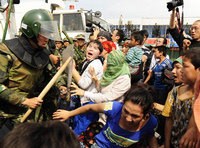'Buying Stability': How China Responds to Protest
By Tom Porter
A somewhat unusual style of governing has evolved in China over the past couple of decades, according to Christopher Heurlin, Assistant Professor of Government and Asian Studies. Speaking at a lunchtime faculty seminar on May 4 titled ‘Buying Stability: State Responses to Protests in China, Heurlin described how protests have become an intrinsic part of political life in China. Heurlin said the Chinese government actually welcomes these protests as a way of gauging popular sentiment, as long as they stay within certain boundaries.
Heurlin spoke with Bowdoin College writer and multimedia producer Tom Porter about the issue of protests in China.
Listen to the interview (audio may take a few seconds to load):
Tom Porter: You subtitled this lecture Responsive Authoritarianism, which was also the name of a book you published on the subject. What do you mean by Responsive Authoritarianism in China?
Christopher Heurlin: By “responsive authoritarianism” I mean that the government is pro-actively monitoring protests and using them to get information about how citizens feel. And not only that but it’s actually acting on this information and changing policies when they gauge popular opposition to be particularly intense or severe.
TP: So in this way, would you say that protesting has been codified as part of the political process in China?
CH: It has in someways become part of a game that the government and the citizens play with one another and it’s in a sense almost a form of bargaining.
TP: So this kind of encourages protests doesn’t it?
CH: This is the downside of it. The government really values these protests as a source of information, but it is also very worried that these protests will get too out-of-control. So I think it definitely does encourage protests, but I think the central government’s hope is that by changing these policies they’ll eventually be able to resolve these underlying grievances and the protests will die down.
TP: You say that a “raft of popular reforms had been introduced in China in the last decade or so. What kind of reforms are those, and were they generally introduced in response to protests?
CH: I think they were mostly introduced in response to those protests and we see reforms in a number of key areas. So one is rural taxation and it has been the biggest source of protest in the 1990s. The central government went on to abolish one of the key rural taxes and as a result there are now very few protests about taxation. Another area is pensions. Pensions in the 1990s were very underfunded and there were many protests from people who were not being paid their pensions. Now there’s a new government law about pensions, and they’re much better funded, so these pension protests have also died away. And the last big one is probably regarding migrant workers: there are new laws now that protect the legal rights of migrant workers and have been influential in helping to address some of the concerns that migrant workers have raised.
TP: How have these protests been characterized? Do they have to stay within certain norms of behavior? Can they be violent? Are the law enforcement authorities trained not to over-react?
CH: They definitely are trained in not over-reacting. China has worked hard in recent years to develop a more capable riot police who won’t respond like they did in Tiananmen Square where they were just mowing everyone down with machine guns, but instead try to manage these protests. And the protesters for their part know that they shouldn’t go too far, and generally will try to avoid violence as a means of keeping things disruptive but still within bounds.
TP: So you’ll see marches, sit-ins, banner-holding, that kind of thing?
CH: Absolutely that’s become very common, especially in front of government offices.
TP: How common?
CH: It’s really hard to say. The last year that the Ministry of Public Security released statistics was around 2005, and they said there were about 74,000 protests in that year.
TP: So it’s part of life in China?
CH: It really is. Protests are almost an everyday experience in some of these major cities.

TP: But I guess there are things you can not protest about, like democratic reform, human rights, is that right?
CH: That’s certainly correct so anyone who’s pushing for changing the really fundamental, political institutions that govern the country, is repressed and we definitely see a lot of that with what we would think of as conventional dissident groups in China.
TP: So it’s basically a way for China to govern itself without being a democracy. Protests are a replacement for the popular vote?
CH: It is in some ways. There’s been a move towards much greater populism in government policy-making and as part of that it’s the protest that’s really driving the direction that these populist policies are going.
TP: So when you think about China and protests and what happened at Tiananmen Square, that’s not really a reflection of how most protests have been dealt with since then?
CH: No, not really since then. Although it’s also the case that people are learning there are these bounds, that you can protest about these economic issues but you can’t protest about political issues. So if a rare political protest does happen, it’s still repressed but mostly along the lines of arresting organizers and sending them to prison.



